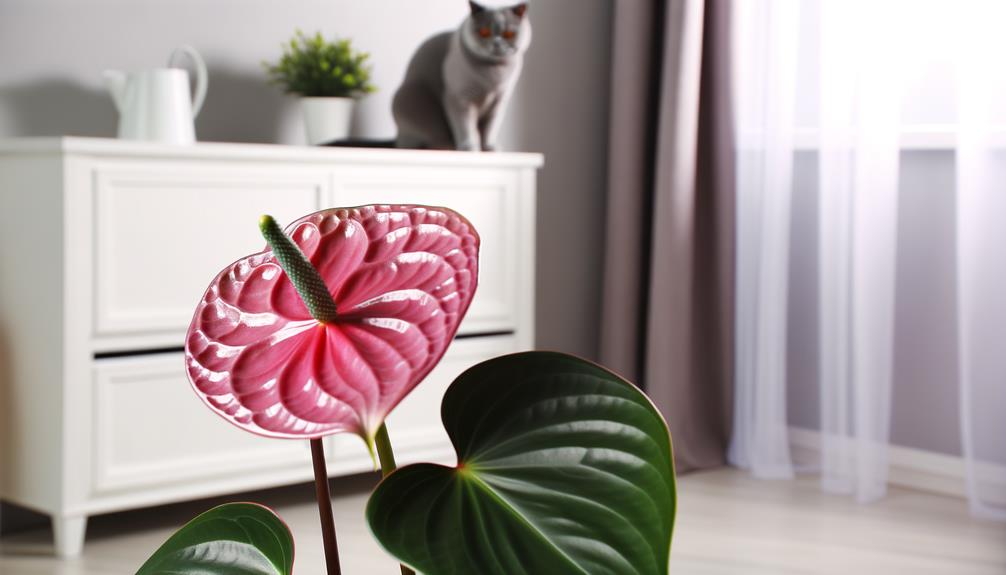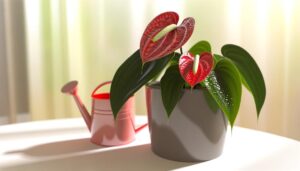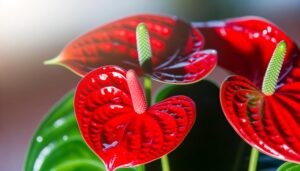Pink Anthurium Safety for Cats
Pink Anthuriums are toxic to cats due to the presence of insoluble calcium oxalate crystals. These crystals cause irritation to the oral mucous membranes, leading to symptoms such as drooling, difficulty swallowing, and vomiting.
Even minimal ingestion can cause harmful reactions. Immediate veterinary consultation is crucial if exposure occurs, with treatments focusing on mitigating mucosal irritation and systemic effects.
To ensure feline safety, it is advised to replace toxic plants with non-toxic alternatives like Spider Plants or Boston Ferns and employ preventive measures to keep such plants out of reach. Explore further strategies to maintain a pet-safe environment.

Key Takeaways
- Pink Anthuriums contain insoluble calcium oxalate crystals that are toxic to cats.
- Ingestion of Pink Anthuriums causes oral irritation, drooling, and vomiting in cats.
- Symptoms include difficulty swallowing, pawing at the mouth, and labored breathing.
- Immediate veterinary consultation is essential for treating calcium oxalate poisoning.
- Replace Pink Anthuriums with non-toxic plants like Spider Plants or Boston Ferns.
Toxicity of Pink Anthuriums
Pink Anthuriums (Anthurium andraeanum) contain insoluble calcium oxalate crystals, which are toxic to cats when ingested. These crystals are needle-shaped and can cause significant irritation upon contact with the mucous membranes.
When a cat chews or ingests parts of the plant, the calcium oxalate crystals can embed in the oral and gastrointestinal tissues, leading to cellular damage. The biochemical mechanism involves the release of histamines and kinins, resulting in an inflammatory response.
Research has documented that even minimal ingestion can lead to adverse reactions. It is pivotal for cat owners to be aware of the plant's toxic nature to prevent accidental ingestion and subsequent veterinary emergencies.
Proper identification and removal of these plants from environments accessible to cats are highly recommended.
Symptoms of Poisoning
When a cat ingests parts of an Anthurium andraeanum plant, it may exhibit a range of symptoms indicative of calcium oxalate poisoning. Clinically, these symptoms often include oral irritation, excessive drooling, and difficulty swallowing. Vomiting is another common manifestation. Additionally, the cat may exhibit pawing at the mouth due to discomfort and swelling of the oral mucosa.
Dyspnea, characterized by labored breathing, can also occur if the swelling extends to the airways. In more severe cases, systemic signs such as lethargy and decreased appetite might be observed. These symptoms result from the needle-like calcium oxalate crystals embedded in the plant tissues, which cause localized trauma to the mucous membranes upon ingestion.
Prompt recognition of these symptoms is essential for timely intervention.
Immediate Actions to Take
Upon recognizing the symptoms of calcium oxalate poisoning in a cat, immediate veterinary consultation is essential to mitigate further complications.
The veterinarian may administer treatments such as intravenous fluids to prevent dehydration and promote renal function. Activated charcoal may be used to limit systemic absorption of the toxin. Additionally, gastrointestinal protectants can be prescribed to soothe the mucosal irritation caused by the ingestion of calcium oxalate crystals.
Monitoring the cat's vital signs, including heart rate, respiratory rate, and body temperature, is critical. Owners should avoid inducing vomiting unless specifically directed by a veterinary professional.
Timely intervention markedly reduces the risk of severe outcomes and promotes a better prognosis for the affected cat.
Cat-Friendly Alternatives
To guarantee the safety of feline companions, pet owners should consider incorporating non-toxic, cat-friendly plants into their home environments. These alternatives not only enhance indoor aesthetics but also pose no risk to cats. Evidence suggests that these plants are safe and even beneficial for felines, providing a source of mild stimulation and aiding digestion.
Recommended cat-friendly plants include:
- Spider Plants: Known for their air-purifying qualities and resilience.
- Boston Ferns: Easy to care for and non-toxic.
- Cat Grass: Aids in digestion and provides entertainment.
- Areca Palms: Safe and elegant indoor options.
- Baby's Tears: Attractive ground cover that is safe for cats.
These choices maintain a harmonious balance between plant care and pet safety.
Preventive Measures
Implementing preventive measures is necessary for ensuring that cats do not come into contact with toxic plants like Pink Anthurium. Strategies include placing the plant out of reach, using deterrent sprays, and providing cat-safe alternatives. Monitoring feline behavior around plants is vital for early intervention.
| Preventive Measure | Description | Effectiveness |
|---|---|---|
| Elevated Placement | Position plants on high shelves or hanging pots | High |
| Deterrent Sprays | Use commercial sprays that repel cats | Moderate |
| Cat-Safe Plants | Substitute with non-toxic plants | High |
| Behavioral Training | Train cats to avoid specific areas | Variable |
Regularly reviewing and adapting these measures enhances the safety of the home environment for cats, reducing the risk of toxic exposure.
Conclusion
To sum up, the ingestion of pink anthuriums poses significant health risks to cats, manifesting through symptoms such as vomiting, oral irritation, and difficulty swallowing. Immediate veterinary intervention is crucial to mitigate these effects.
How can cat owners guarantee the safety of their pets while maintaining an aesthetically pleasing environment? By choosing non-toxic, cat-friendly plants and implementing preventive measures, pet owners can create a harmonious living space that prioritizes the well-being of their feline companions.






